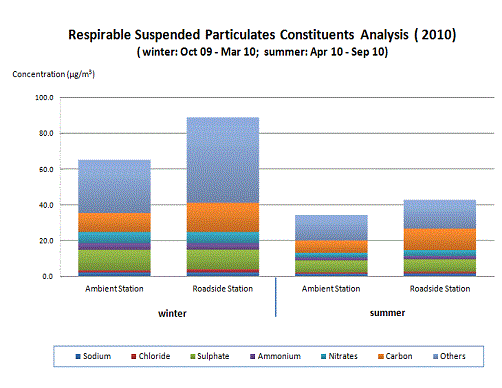Respirable and Fine Suspended Particulates
Respirable and Fine Suspended Particulates (PM10 and PM2.5)
In Hong Kong, the ambient particulate matters (PM) are contributed mainly by the regional sources. Combustion sources, in particular diesel vehicle exhaust and emissions from power plants, are the major local sources of PM. Besides, fine particulates can be formed by atmospheric oxidation of SO2 and NOx. Although to a lesser extent, crustal dust and marine aerosols are also sources of PM.
PM with particle sizes less than 10 microns, which are known as respirable suspended particulates or PM10. For those with particle sizes of 2.5 microns or less, which are commonly referred to as fine suspended particulates or PM2.5.
Depending on their sources and the existing meteorological conditions, RSP can be made up of a number of different constituents.
Particulates Constituents
The RSP consists of a number of components, including salts (such as nitrates, sulphates), organic chemicals, metals, and soil or dust particles. Organic chemicals and sulphates are the main contributor to the RSP mass concentrations. A number of constituents of RSP and their sources are given in the table below.
| Chemical constituent | Source |
|---|---|
|
Silicon, aluminum, calcium, manganese and iron |
Soil/crystal and construction activities |
|
Vanadium and nickel |
Oil fired combustion |
|
Cadmium and hydrocarbons |
Incineration |
|
Carbon, lead, bromine and hydrocarbons |
Vehicle emissions |
|
Sodium, chloride, magnesium, and potassium |
Marine aerosols |
|
Nitrates, sulphates and ammonium |
Secondary pollutant formation |
Other chemicals in RSP that are tested by the EPD are barium, copper, zine, beryllium, mercury, chromium, arsenic and selenium.
